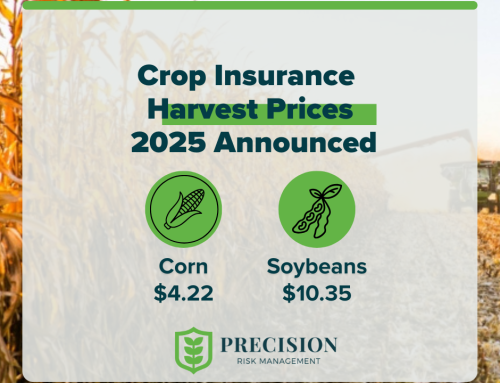Technology is transforming ag quickly and that creates new risks for farmers in farm cybersecurity. From AI tech to cloud-based grain systems and GPS-guided machinery, farms are more connected than ever before. But that connection brings potential risks. Cyberattacks are now one of the fastest-growing threats to large farming operations.
At Precision Risk Management (PRM), we help reduce your total operational risk and keep you aware of new risks as they emerge. As farms increasingly rely on digital tools, cybersecurity is becoming just as essential as crop insurance to protecting your operation.
The Rising Threat of Cyber Attacks on Farming Operations
In 2024 alone, the food and agriculture sector experienced 212 ransomware attacks, a 27% jump from the previous year1. The sector now ranks as the seventh most targeted industry in the U.S., right behind manufacturing and finance2.
These attacks are not just targeting major corporations. In one case, a farm’s robotic milking system was disabled by ransomware, leading to the death of a pregnant cow and major financial loss3.
The FBI sums it up well. “The cyber risk and national security threat to farms, ranches, and food processing facilities is growing exponentially,” said FBI Special Agent Gene Kowel, Agriculture Threats Symposium, 2024.
Why Agriculture Attacks Are Growing
As farming operations adopt robotics, precision agriculture, and remote monitoring systems, they open the door to cyber intrusions with your farm cybersecurity. Many of these technologies were not originally designed to withstand modern threats and now sit vulnerable on global networks4.
Meanwhile, attackers are becoming more sophisticated. AI-powered hacking tools can generate realistic phishing emails, bypass security protocols, and exploit system vulnerabilities with very little manual effort by the hackers5.
What’s at Risk for Your Operation with Farm Cybersecurity
A successful cyberattack can do more than just crash your email. For large operations, the consequences can be catastrophic:
- Delayed planting or harvesting, especially during tight seasonal windows6
- Disabled feeding systems for livestock or disrupted temperature-controlled storage7
- Theft of operational records, or financial data
- Loss of business operations and consumer confidence
When New Cooperative, Crystal Valley Co-op, and JBS were hit in 202, they paid $11 million in ransom to restore U.S. meat processing systems. It quickly became clear that cyber incidents can derail entire food chains9.
7 Action Steps to Protect Your Farm’s Digital Infrastructure
The good news is, there are simple steps to protect your operation from these cyber threats. The following steps are drawn from CISA, Food and Ag-ISAC, and agribusiness cybersecurity experts. Together, they offer a practical roadmap to defend against digital threats.
1. Use Strong Passwords or Passphrases
Weak or reused passwords are a leading vulnerability. Use unique passphrases and avoid sharing credentials across systems.
2. Turn on Multi-Factor Authentication (MFA)
This simple measure blocks more than 99% of common account attacks10. Apply it to everything from email accounts to operational software
3. Train Employees to Spot Phishing
Phishing emails remain one of the top entry points for attackers. Anyone using your operations email systems, such as employees, should be taught to recognize suspicious links, spoofed domains, and fraudulent requests.
4. Update Systems and Patch Vulnerabilities
Many ransomware attacks exploit known issues. Regularly update software, firmware, and connected devices to eliminate entry points. These updates should be done as soon as they released. Delay gives attackers an opportunity to exploit known issues.
5. Back Up Critical Data Securely
Keep multiple, encrypted backups stored offline. This is your best safeguard against ransomware, especially when attackers threaten data destruction.
6. Keep it Separate and Segment Your Tech
Separate your business systems (email, payroll) from operational technologies (GPS tractors, dairy control systems). This means setting up different WiFi and internet connections for different business needs or utilizing existing firewalls to block traffic between these systems. This can limit exposure to different systems during an attack.
7. Develop and Test an Incident Response Plan
Have a plan in place before an attack occurs. CISA offers free templates and simulation exercises tailored to the ag sector. These tools are mainly built for extremely large food manufacturers but grower may still find it useful depending on their level of technology dependence.
PRM is Committed to Keeping You Informed About Cyber-Risk
At PRM, we believe risk management must evolve with the times. That’s why we encourage all our partners to take cybersecurity seriously, just as they would hail or yield loss.
We don’t just help protect your farm. We help you protect your operation’s long-term success. Our team is here to help you think holistically about total operational risk. As cyber-risk becomes more critical, PRM will keep you informed how to be cyber-aware and safe.
Resources to Get Started
- CISA Cyber Checklist for Agriculture
- Purdue University Best Practices
- USDA’s Guide For Cybersecurity
Farming in 2025 isn’t just about yields and equipment. It’s about protecting every layer of your operation. From the soil to the server, PRM has your back.
Citations and Sources
(6,8,10) Food and Ag-ISAC. Ransomware Analysis: Food and Ag-ISAC, 2024.
(1-4,7,9) Daphne Ewing-Chow. Agri-Food Sector Under Increasing Threat From Cyber Attacks. Forbes, 2024.
(12) Cybersecurity and Infrastructure Security Agency (CISA). Food and Agriculture Cybersecurity Checklist and Resources, 2025.
(5) Dr. Trey Malone. Why Cybersecurity Must Be a Top Priority for Agribusiness in 2025. Purdue University, 2025.





